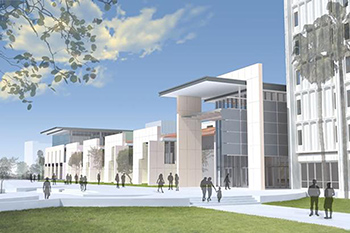UC Santa Barbara’s Davidson Library Under Construction
 SANTA BARBARA, Calif. — The Davidson Library at the University of California, Santa Barbara (UCSB) is undergoing significant renovations for the next several months. C.W. Driver, the project builder, is tackling the construction work—adding a new section and making the existing building more seismically sound. The scope of the project also includes upgrading the fire alarm and life safety systems in the building.
SANTA BARBARA, Calif. — The Davidson Library at the University of California, Santa Barbara (UCSB) is undergoing significant renovations for the next several months. C.W. Driver, the project builder, is tackling the construction work—adding a new section and making the existing building more seismically sound. The scope of the project also includes upgrading the fire alarm and life safety systems in the building.
The overall goal of the project, according to Sam Huleis, senior project manager with C.W. Driver, is to “expand and update the library with the latest advances in information technologies and to strengthen its position as one of the best research libraries in the country.” The team working on the project includes Pfeiffer Partners Architects, structural engineer John A. Martin & Associates and Karl Burrelsmann as UCSB’s representative.
Construction on the $53 million project began on Aug. 15 and is expected to end in December 2015. The 340,000-square-foot library is located in the center of UCSB’s campus and stands as a defining centerpiece for the school. The new additional wing on the north side will add an extra 62,000 square feet to the facility once the project is complete. A three-story glass walkway will connect the new wing to the preexisting building.
The library’s 24-hour study room will include more study spaces and design elements to increase workspace and allow for more natural light to enter the area. New study areas featuring glass walls will be located along the western side of the two-story section of the library.
Numerous other design elements will characterize the project as well. The project team will incorporate sun shading integrated into the building’s architecture, broad roof overhangs that will shade the building’s façade and a metal sunshade on the western side. Additional design elements include constructing the building as an exposed concrete structure to minimize unnecessary external finishes, a raised floor system that will increase efficiency throughout the facility, low-E glazing, dual-flush restroom facilities and waterless urinals and an efficient chilled beam cooling system.
Another major aspect of the construction process will be upgrading the building’s seismic stability to comply with current codes. “The seismic upgrades are being done on the two-story and eight-story portions of the library, which were built in the early 50s and 60s, respectively,” said Huleis. “The seismic upgrades consist of a combination of supplementing the existing building foundation system with additional foundation structures, adding concrete shear walls at various bays of the building and reinforcing certain existing concrete walls and roof structures with structural fiber reinforced overlays.”
The project team anticipates facing numerous challenges while working on the project as well. The library will remain open during construction, which means that much of the work will be completed during night shifts and school breaks. “This renovation project has a targeted focus on seismic upgrades and as such, our primary concern is for the safety and well-being of the students for the duration of the project. We want to maintain a safe environment conducive for students to continue learning,” Brett Curry, vice president of operations with C.W. Driver, said in a recent statement.
Construction involving spaces not used by students or faculty will be conducted during daytime hours. Because of the constant flow of work the building will be undergoing, there will be double the construction crews and supervisors working on the project so that work on the interior and exterior of the building can occur during the same timeframe.
Protecting the library’s books is another challenge, Huleis said. “Although book stacks will be completely protected with shrink wrap in the areas of work, the books still need to be retrieved upon request. C.W. Driver will work with the library staff to train individuals who will be designated to retrieve books in the areas of work,” he said.
The third challenge Huleis anticipates facing is the issue of dust generated from construction tools while drilling about 15,000 dowel holes into the existing concrete of the eight-story building. “C.W. Driver will contain these areas of work with temporary enclosures that are completely sealed from the rest of the floor area and implement negative air pressure to keep the dust from migrating into the occupied spaces,” Huleis said.
Despite the challenges the team will face during construction, the project shows promise to help facilitate UCSB’s academic reputation upon its completion. The project team is aiming for LEED Silver certification for the new library.
